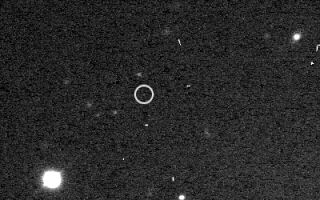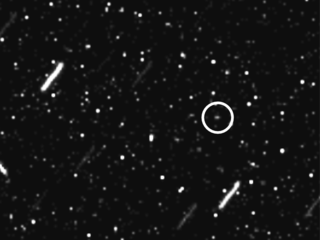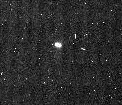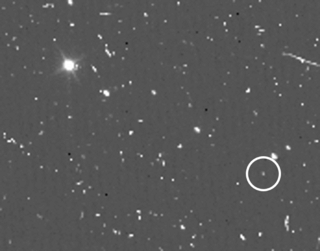
Pasiphae, formerly spelled Pasiphaë, is a retrograde irregular satellite of Jupiter. It was discovered in 1908 by Philibert Jacques Melotte and later named after the mythological Pasiphaë, wife of Minos and mother of the Minotaur from Greek legend.

Themisto, also known as Jupiter XVIII, is a small prograde irregular satellite of Jupiter. It was discovered in 1975, subsequently lost, and rediscovered in 2000.

Praxidike, also known as Jupiter XXVII, is a retrograde irregular satellite of Jupiter. It was discovered by a team of astronomers from the University of Hawaii led by Scott S. Sheppard in 2000, and given the temporary designation S/2000 J 7.

Skathi, also named Saturn XXVII and originally spelled Skadi, is a natural satellite of the planet Saturn. Skathi is one of Saturn's irregular moons, in its Norse group of satellites. It was discovered on September 23, 2000, by a team of astronomers led by Brett Gladman. The team announced their discovery on December 7, 2000, along with seven other satellites of Saturn, namely; Tarvos, Ijiraq, Thrymr, Siarnaq, Mundilfari, Erriapus, and Suttungr. The moon was named after Skaði, a figure in Norse mythology, as part of an effort to diversify the largely Greek and Roman names of astronomical objects.

Ymir, or Saturn XIX, is the second-largest retrograde irregular moon of Saturn. It was discovered by Brett J. Gladman, et al. in 2000, and given the temporary designation S/2000 S 1. It was named in August 2003 after Ymir, who in Norse mythology is the ancestor of all the Jotuns or frost giants.

Narvi or Saturn XXXI is a natural satellite of Saturn. It was discovered by a team of astronomers led by Scott S. Sheppard in 2003, and given the temporary designation S/2003 S 1.

Suttungr, or Saturn XXIII, is a natural satellite of Saturn. It was discovered by Brett J. Gladman, et al. in 2000, and given the temporary designation S/2000 S 12. It was named for Suttungr in Norse mythology, a Jötunn or giant who once owned the mead of poetry.
Fenrir, or Saturn XLI, is a natural satellite of Saturn. Its discovery was announced by Scott S. Sheppard, David C. Jewitt, Jan Kleyna, and Brian G. Marsden on May 4, 2005, from observations taken between December 13, 2004, and March 5, 2005. Fenrir has an apparent magnitude of 25, making it one of the faintest known moons in the Solar System, and was discovered using some of the largest telescopes in the world. It is even too dark to have been observed by the Cassini spacecraft when it was in orbit around Saturn, for which it never got brighter than approximately 17th apparent magnitude. Fenrir was named after Fenrisulfr, a giant wolf from Norse mythology, father of Hati and Skoll, son of Loki, destined to break its bonds for Ragnarök.

Fornjot or Saturn XLII is the outermost named moon of Saturn. Its discovery was announced by Scott S. Sheppard, David C. Jewitt, Jan Kleyna, and Brian G. Marsden on 4 May 2005 from observations taken between 12 December 2004, and 11 March 2005. It had the largest semi-major axis among all the known moons of Saturn until the recovery of Saturn LVIII in 2019.

Hati or Saturn XLIII is a natural satellite of Saturn. Its discovery was announced by Scott S. Sheppard, David C. Jewitt, Jan Kleyna, and Brian G. Marsden on 4 May 2005, from observations taken between 12 December 2004 and 11 March 2005.
Farbauti or Saturn XL is a natural satellite of Saturn. Its discovery was announced by Scott S. Sheppard, David C. Jewitt, Jan Kleyna, and Brian G. Marsden on May 4, 2005, from observations taken between December 12, 2004, and March 9, 2005.

Bestla or Saturn XXXIX is a retrograde irregular moon of Saturn. Its discovery was announced by Scott S. Sheppard, David C. Jewitt, Jan Kleyna, and Brian G. Marsden on 4 May 2005, from observations taken between 13 December 2004 and 5 March 2005.
Aegir, also Saturn XXXVI, is a natural satellite of Saturn. Its discovery was announced by Scott S. Sheppard, David C. Jewitt, Jan Kleyna, and Brian G. Marsden on May 4, 2005, from observations taken between December 12, 2004, and March 11, 2005.

Bebhionn, also known as Saturn XXXVII, is a small, irregular natural satellite of Saturn. Its discovery was announced by Scott S. Sheppard, David C. Jewitt, Jan Kleyna, and Brian G. Marsden on 4 May 2005 from observations taken between 12 December 2004 and 9 March 2005.

Hyrrokkin or Saturn XLIV is a natural satellite of Saturn. Its discovery was announced by Scott S. Sheppard, David C. Jewitt, Jan Kleyna, and Brian G. Marsden on June 26, 2006, from observations taken between December 12, 2004, and April 30, 2006.

Kari or Saturn XLV is a natural satellite of Saturn. Its discovery was announced by Scott S. Sheppard, David C. Jewitt, Jan Kleyna, and Brian G. Marsden on 26 June 2006 from observations taken between January and April 2006.

Greip or Saturn LI is a natural satellite of Saturn. Its discovery was announced by Scott S. Sheppard, David C. Jewitt, Jan Kleyna, and Brian G. Marsden on 26 June 2006, from observations taken between 5 January and 1 May 2006. Greip is about 6 kilometres in diameter, and orbits Saturn at an average distance of 18,066 Mm in 906.556 days, at an inclination of 172.7° to the ecliptic, in a retrograde direction and with an eccentricity of 0.3735, and is presumably at high risk of eventually colliding with Phoebe. It is unknown whether Greip is more similar to Suttungr or Hyrrokkin in color. Its rotation period is most likely 12.75±0.35 hours with two minima in the light curve, but a longer period of 19 hours cannot be ruled out due to the short observation time by Cassini–Huygens.

Loge or Saturn XLVI is a natural satellite of Saturn. Its discovery was announced by Scott S. Sheppard, David C. Jewitt, Jan Kleyna, and Brian G. Marsden on 26 June 2006, from observations taken between January and April 2006.
Surtur or Saturn XLVIII is a natural satellite of Saturn. Its discovery was announced by Scott S. Sheppard, David C. Jewitt, Jan Kleyna, and Brian G. Marsden on June 26, 2006 from observations taken between January and April 2006. It was named after Surt, a leader of the fire giants of Norse mythology.

Skoll or Saturn XLVII is a retrograde irregular satellite of Saturn. Its discovery was announced by Scott S. Sheppard, David C. Jewitt and Jan Kleyna on 26 June 2006 from observations taken between 5 January and 30 April 2006.

















